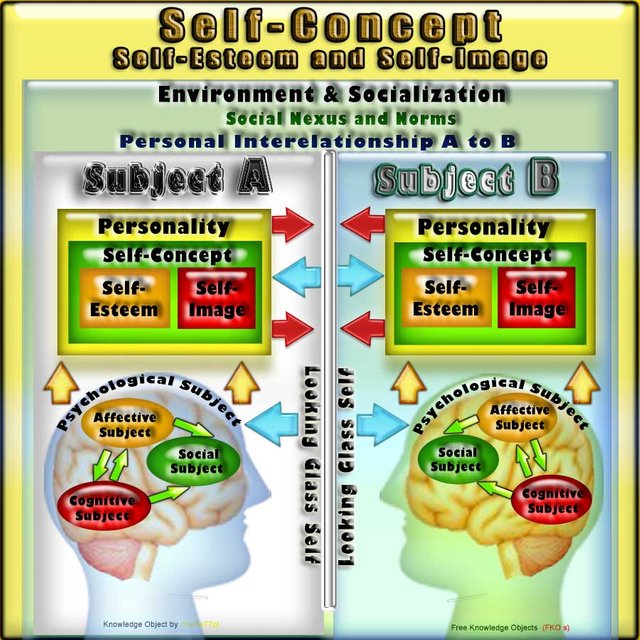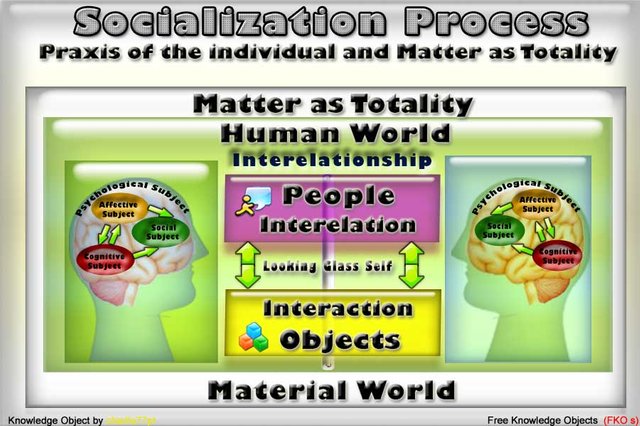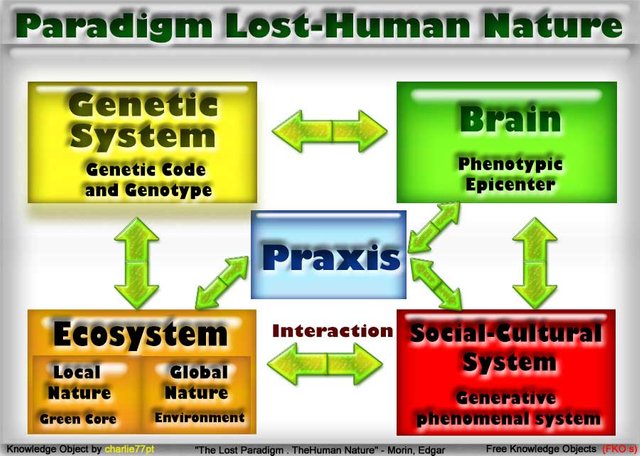Self-concept, Self-Esteem and Self-Image - The Human Nature Part 3
Self-concept, Self-Esteem and Self-Image - The Human Nature Part 3
Read Part 1 Self-concept, Self-Esteem and Self-Image - The Human Nature Part 1
Read Part 2 - Self-concept, Self-Esteem and Self-Image - The Human Nature Part 2 - From Birth To Individual Praxis
Part 3 - Praxis of the individual and Matter as Totality
3- Praxis of the individual to Practical-Inert
"Pass to desire to possess Ariadne's thread to lead us out of the individual praxis to the various forms of human groups."
"Reason and Violence" -
R. D. Laing and D. G. Cooper
History is a totalization, therefore the praxis (action) is the only individual time factor of Totalization, we need to find out how a multitude of individuals also produces an action (praxis), through a multiplicity of Totalizations.
It is necessary to clarify the dialectic in which the praxis becomes a praxis-process. The individual during his life goes through various institutions (family, school, work).
Then we have to discover the needs of transformation of the praxis, from the series to the group and the series.
We'll talk of groups of groups: The social classes and the "Class Being", referring to its internal structures and relations with other classes.
The aim is then to figure out how inside the historical movement, a variety of man comes to be defined by the shape of their conflicts and how this fact is projected self-concept of each man through identification papers with models and comparison with others.
Individual Praxis as Totalization
"... Personal life in terms of Sartre as" made-constituent "as a synthetic unity of what "we do what we are made of" - "Reason and Violence"
R. D. Laing and D. G. Cooper
Sartre believes that man is mediated by things in the the same extent that things are mediated by man, man this related to materiality and through other men.
The relationship thus conceived, is an example of spirality of dialectical thinking.
This type of analysis is required the interpretation of man in "human landscape", this reasoning allows us to understand the means by which a plurality is constituted as a Total (a "Totalization" according Sarte), is an whole-subject or a whole-object.
A totalization is a unifying organization of a plurality and humanity is a plurality of such organizations. The totalizing relation of the material, the man with the material world is defined by need.
The need destotalizes the totality, creating a dialectic of totalization-distotalization-retotalization. It is an internalization, made by man, in need of a shortfall in the total field of satisfactions.
The distotalization is an "Injection-of-Nothing-the-World", creating with it a univocal relationship and not reciprocal, which is expressed on an individual praxis.
The field of individual praxis (it's a Totality) is totalized as a unit of resources and means to meet the satisfaction of needs. This field is an inert plurality of inert resources and means, if we see it as an instrumental field.
It is n praxis it is that it will find areas or objects that privileged totality. The body is always in need: the need to function and praxis.
"Personal action can either open out possibilities of enriched experience or it can shut off possibilities. Personal action is either predominantly validating, confirming, encouraging, supportive, enhancing, or it is invalidating, disconfirming, discouraging, undermining and
constricting. It can be creative or destructive."- Laing, R.D. "The Politics of Experience "
Human Relations as mediation between different sectors of Materiality
Man is always related to the matter and through other men. Interpersonal relationships are intermediate of the material field, mediated in and through the material field are conditioned by external factors.
The materiality is inert (total possible praxis) and is current as "escapes us" because of the multitude of other unicities or totalizations, made by others, and which complement or not ours.
The totality of my praxis is possible to be distotalized for being field of a totalization of others praxis, which are only part of his Totalization.
In this dialectic materiality will become a vehicle of meaning.
In other words, the degree to which the actions of others confirms our expectations about them and the extent to which our behavior meets the expectations that others have about us, depends on the ability and willingness to behave hands in a manner regular and predictable (with the consequent introjection commitment or violence).
Reciprocity each can make the end of another vehicle for you, just as the other for himself a vehicle of our purposes.
Reciprocity will have the character of exchange, which made the field of materiality is established by the ratio of the concept value use- exchange value.
So in reciprocity we are the same time, object and instrument of the ends of the other, by the fact that become object and instrument of our purposes, keeping in mind however each as a product of your product.
In this exchange, it is the totalization of the self-concept and the organizing unit of multiplicity, the glass- looking-self. You should be always remember the materiality field where the exchanged is made, always conditioned by the Totality of History.
The unification is mutual recognition, as two agents, each integrating the entire universe.
However, the unification which constitutes over a relationship of materiality, a class of the objects(classification) and its use (serialization), transforms the person and determines their relationship.
"The Other (as the third) is the non-reciprocal mediator of the unification of the dyad."
"Reason and Violence"
The sum of human actions always mediated by matter, is totalization made to matter in human relationships on one hand and on the other hand totalization made to human relations by matter.
4- Matter as Entirety totalized and a first experience of Need
"I exist only through those who are nothing of your being by me." - Jean Genet -
(Quoted in "Reason and Violence")
"Dialectics is the law of totalization. Collective organizations, societies, history.
Realities imposed or that are imposed on the individual " - "Reason and Violence" (Cited above)
Human history is totalization (on) this past and future orientation as men make history based on previous conditions. The idea becomes something meant for things and not a significant act.
Matter, as a negation of man is however the only totalizing reality of history.
The relationship of a multitude of subjects to the field where the praxis emerges by the need (born in the relationship of each to the field and the reciprocity between subjects), is the fundamental relationship of our history and the reciprocity of need-scarcity ( exchange value - use value).
The dialectics of need-scarcity is an enabling factor for the explanation of History. The individual himself is both redundant and scarce when inserted within a group.
Conditioned by matter man acts not only by need, but also responds to the object requirements (thing) over it. These requirements also influence the creation of the group.
The contradiction of class interests (Marxist sense) reveals the individual trying to find the original link with the matter.
The action to meet the need is restricted by another, creating a change to move from "my-action-for-me" to "my-action-for-itself".
The "otherness" will be the structural aspect of the transition from "self-to-the-self" to "other-for-the-other." The move will be to change the underlying materiality ratio is the objectification of materialized praxis.
Man is therefore found in the dialectic created between objectifications (appropriations of matter) of Praxis material and its alterations as "Other-for-the-Other" "
see the relation of the cognitive subject to the appropriation of the field of materiality via e need /desire (as affectivity).
We found the mirror of the dialectics of affective-cognitive subject of J.M. Dolle on the concepts of otherness and objectification.
We went for History by bringing the man to the first object and the emergence of logical structures of the cognitive subject.
Animal surrounded by nature, there is the existential activity of Sapiens, product interaction of four systemic poles:
1 - The Genetic System (genetic code, genotype)
2 - The Brain (Phenotypic epicenter)
3 - The Social-Cultural System (generative phenomenal system)
4 - The Ecosystem - while Local Nature (Green Core) and Global Nature (Environment)).
Morin, Edgar * - "Paradigm Lost - Human Nature."
The Class Human Being
"When appears Sapiens man is already socius-faber-loquens" - Morin, Edgar - "Paradigm Lost"
The alienation of individual praxis by the change and objectification of "Being-for-the-Other" is "Be-out-of-Thing", constitutes itself and is constituted as practical-inert matter.
Being "class" (rated) as internalized inertia in each affects them and their destination. The values of class structures, as collective inertia, are shared in the field be for all individuals.
This allows us to state that the vague supraindividual "class consciousness", will be largely related to the self-concept.
The Looking-Glass-Self appears as an expression of the dialectic between alterations and objectifications, verified in the exchange among men and by materiality.
Collectives
"Social phenomenology is the science of my own and of others' experience. It is concerned withn the relation between my experience of you and your experience of me. That is, with inter-experience, It is concerned with your behavior and my behavior as I experience it, and your behavior and my behavior as you experience it." - Laing, R.D. "The Politics of Experience "
The realities of praxis in the measure that are made in and trough themselves, the interpenetration of a plurality of individuals arranged in a Totalization are the product of human labor.
The group is a form of integration, of a multiplicity of individuals that through joint action produces a form to be established as a unit or series.
The seriality will be the internal-external relationship. The metamorphosis of the multiplicity of a series is the "serialization".
The series only becomes noticeable by the apprehension of formal and universal structure of Otherness.
There will also be an Other "series" as "Being-common-to-all".
The social field of the series, is the unity of "otherness" and a semi-plurality. A class view in the practical-inert field is a number and "being-in-class" status seriality tax to the multiplicity of individuals who compose it.
The structure of each relationship is in each one as well as the internalized of that relationship.
This structure has a dual property: be inert (considering the structure and outline) and be dynamic (effective held by praxis of each and every one).
The relational system is therefore both an instrument and a limit of thought. The system is therefore composed of logical relations generalized, whose logical principles are the underlying commitment of the relationship itself.
Interpersonal action exists in each individual praxis as interiorized unity of multiplicity.
Each individual praxis as interiorized unity of multiplicity appears as omnipresent and ubiquitous group action .
"We can see other people’s behavior, but not their experience. This has led some people to insist that psychology has nothing to do with the other person’s experience, but only with his behavior.
The other person’s behavior is an experience of mine. My behavior is an experience of the other. The task of social phenomenology is to relate my experience of the others behavior to the others experience of my behavior. Its study is the relation between experience and experience: its true field is inter-experience." -
"Laing, R.D. "The Politics of Experience "
Hence it infers the relationship of "looking-glass-self" in the dialectics of "Praxis -" Practical-Inert "-" Praxis ".
In the constitution of the group or series, we should play to the degree in which the actions of others confirms our expectations of them, and the extent to which our behavior meets the expectations that others have about us. Even speak of a self-concept "serialized" as the product of individual self-concepts.
The social roles also involve "performance" in accordance with the expectations of others. People validate their opinions and abilities, comparing the "performances" and personal values with those of others.
The question of expectations that is the "be-another-for-the-other" brings us the problem of compliance and the violence perpetrated by society group-work-school-family-mother in a hierarchical structure of class society.
Expectations and conformism settle the dialectic between culture and the occupation of the various social positions that require "performance" and appropriate formal paper, which are in any individual in the assessment he makes of himself through others (looking-glass-self).
"The relationship between individuals, as the relationship between the individual and the group is controlled by a dual principle of cooperation, solidarity on the one hand and competition-antagonism on the other hand the individual to individual relationship ... . ... feeds the double complement antagonist principle of social organization. " - Morin, Edgar - "Paradigm Lost"
We finish here with the same slide we started in part 1 to remember and integrated the concepts you have been reading

The end of the post Part 3- Praxis of the individual and Matter as Totality of the series Self-concept, Self-Esteem and Self-Image - The Human Nature
Adaptation, translation and visual graphics refresh of an article in portuguese made by me and a friend published in the web in 1993 in a site called www.cultkitsch.com - by to-zé s. & charlie777pt
Read Part 1 - Self-concept, Self-Esteem and Self-Image - The Human Nature Part 1
Read Part 2 - Self-concept, Self-Esteem and Self-Image - The Human Nature Part 2 - From Birth To Individual Praxis
Other Posts on Psychology
Insight as Self Consciousness - Insight as Self Consciousness Insight has a generating mechanism of the Cathartic Process
Bibliography (based in some of the books in portuguese)
DOLLE, Jean Marie, "From Freud to Piaget", Moraes
LAING, R.D. e COOPER, D.G., "Reason and Violence", Vozes
LAING, R.D., "The divided Self", Vozes
OPEN UNIVERSITY, "Social Relationships", Part 2
DOLLE; Jean Marie, "To understand Piaget"
ARGYLE, Michael, "The Psychology of Interpersonal Behaviour", Pelican
PERRET-CLERMONT e ANNE-NELLY, "Construction of Intelligence by Social interaction", Sociocultura
HINDE; Robert A., "Towards Understanding Relationships", AP
PINTO, Jorge Bento, "Sobre a Concepção da Vinculação", Análise Psicológica Nº 1/2 Serie III
LAING; R.D., "The politics of Experience and the Bird-of-Paradise", Vozes
FÉDIDA, P., " Concept and Violence ", Sociocultura
LAPLANTINE, "Ethnopsiquiaty", Vega
MORIN, Edgar, "The Lost Paradigm . The Human Nature", Europa-América
LAING, R.D., "Self and Others", Vozes
Index of the posts
Prelude
Note Treshold
Part 1
1 - The Lost paradigm or the Establishment of a Theoretical Model
- The Subject
- Self-Concept, Self Esteem and Self-Image
- The Looking-Glass-Self
- Socialization
Part 2
2 - From birth To Individual Praxis
- From Libidinal Object to the Permanent Object
- Of Reflexes in the Relationship Systems Mother-Son
- Afterword to the Chapter or Preface Chapter Later
This Post
Part 3 - Praxis of the individual and Matter as Totality
3 - Praxis of the individual to Practical-Inert
- Individual Praxis as Totalization
- Human Relations as mediation between different sectors of Materiality
4 - Matter as Totality totalized and a first experience of need
- The "Class" Being
- Collectives
- Bbliography

